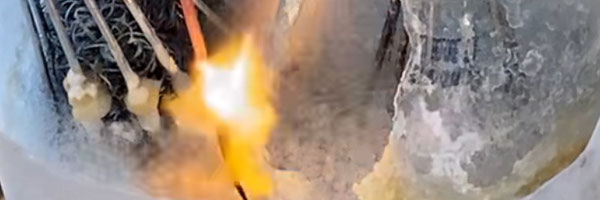The Production of Propellant on other Planets
Grade 7
Presentation
Problem
My problem is that if mars is colonized, we will need to somehow get lots and lots of rocket propellant there. Shipping would be very expensive, so we would need to produce it there. I will investigate one method for doing this; electrolysis.
From electrolysis, one type of rocket fuel is produced. Oxygen and hydrogen, the gasses produced by electrolysis, can be used as propellant. Some rockets that use oxy-hydrogen include: the saturn V, space shuttle, Ariane V, and more. Electrolysis is relatively cheap to preform, costing only water, electricity, and some chemical to reduce the impedance of the water. Water has been found on many places other than Earth. It can exist as a liquid, like under the europan ice, but it usually is found as ice, like on the moon, mars, and even pluto! Electricity can be obtained by many means; solar panels, wind turbines, hydrocarbon generators, geothermal plants, nuclear plants, the list goes on. If a colony is being created then there will likely be some form of power generation anyway. An impedance limiter is only needed in small ammounts. They can be imported, mined or synthesized from thin air.
Method
I will attempt to produce enough gas to make brown's gas bubbles in a small bowl of dish soap with water. The setup is as follows: the cut off base of an apple juice jug, which is filled with water that is then brought to saturation with baking soda. Two whisks attatched to the top of a soda bottle each are then placed in the mixture. There is aquarium tubing attatched to each whisk which then goes into a jug filled most of the way with water. The tubing is placed so it ends just below the waterline. The gasses will then bubble up through the water and into the little airspace in the jug, eventually exiting through the final tube into a small dish with dish soap and water to create explosive bubbles. I will then ignite these bubbles with a bbq lighter, demonstrating the energy produced. There are five nine-volt batteries which are attatched with aligator clips to the whisks, to generate the aforementioned gasses (hydrogen and oxygen).
Research
Electrolysis is the process of forcibly splitting water molecules using electricity. Due to water molecules being ionically bonded (opposing polarity of each atom) applying electrical current will attract each atom respectively by polarity, splitting the bond and resulting in the two components (hydrogen and oxygen). Here's the source I used to validate my understanding of electrolysis.
For this project, the main subject of research is the production of brown's gas (a mix of hydrogen and oxygen). The construction of the apparatus was based on a video by nighthawkinlite, linked here (see 7:38-10:07). Many changes were made from the original design, but this was where it began.
Data
During my first experiment, nothing happened beyond some foamy water in near the whisks. I theoize that this was because of a low amperage provided by the 5 9V batteries, totalling at only around 5 AH of electricity. To rectify this, I switched to a 6V 11 AH lantern battery. Despite this 210% increase in amperage, my next two experiments would show similar results. My fourth experiment was quite similar, except I used two lantern batteries (wired positive to one electrode and negative to the other), and replaced the baking soda mixture. It produced a slightly larger volume of bubbles, but still not nearly enough. At this point, it was clear that I needed to pivot, so I did. I removed most of the setup until it was just the whisks in the basin of liquid, and decided to ignite the bubbles created at them directly. This, finally, was a success.
Conclusion
In this project, I set out to produce rocket fuel through electrolysis. Origionally, I had planned to have the gas travel through tubes and gather in one spot, where it would create bigger, better, louder bubbles, but my scale was just too small. What my experiments have demonstrated, however is that the concept of electrolysis can work, and that it can produce a flammable gas for use as rocket fuel. My next steps are further investigating the feasability of large scale production on other planets. I would also research sources for the requited electricity which could be easily built outside of Earth.
Citations
Here's the source I used to validate my understanding of electrolysis.
Acknowledgement
I would like to aknowledge my grandfather George Gibson, for helping with troubleshooting, and my mother Janelle Gibson-Haerle for materials and a test space.

